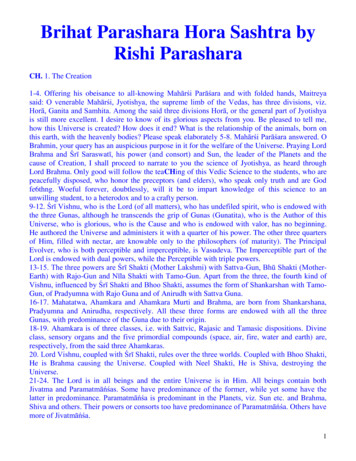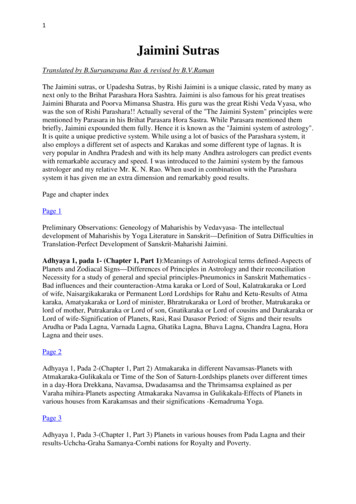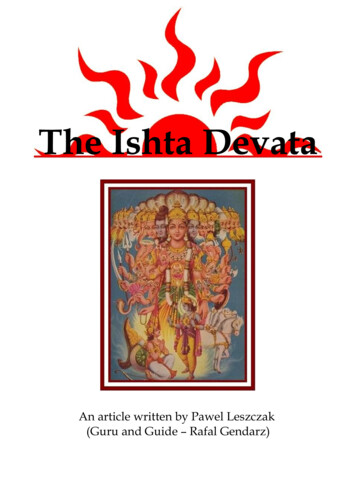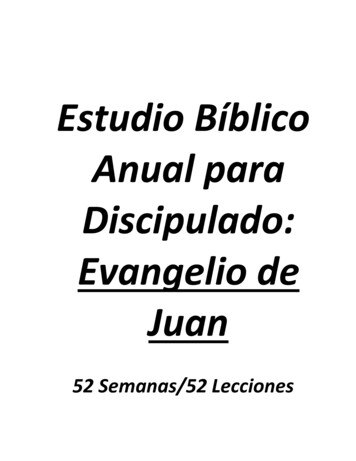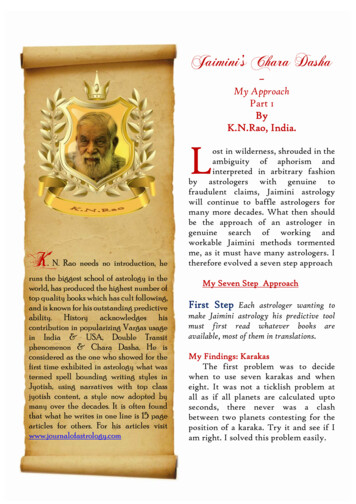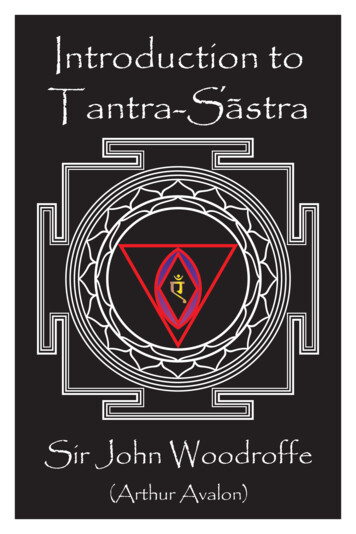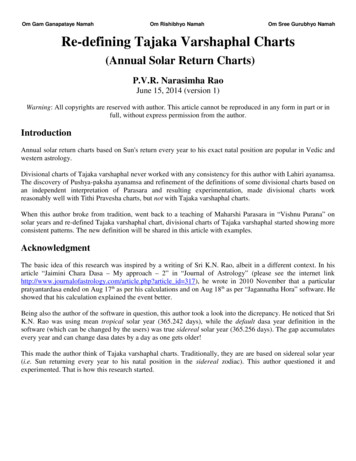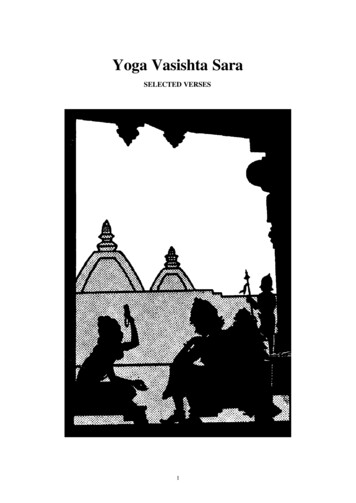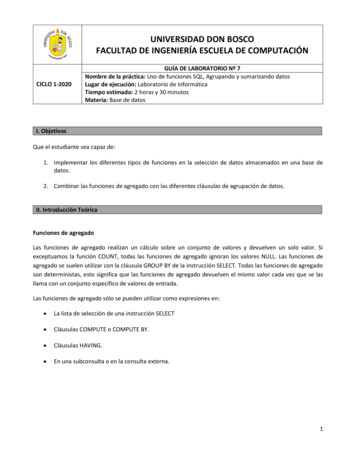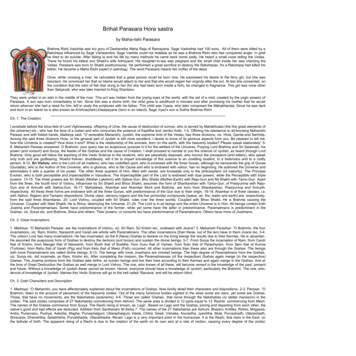
Transcription
Brihat Parasara Hora sastraby Maha-rishi ParasaraBrahma Rishi Vasishta was kul guru of Dasharatha Maha Raja of Ramayana. Sage Vashishta had 100 sons. All of them were killed by aRakshasa influenced by Sage Vishwamitra. Sage Vashita could not retaliate as he was a Brahma Rishi who has conquered anger. In griefhe tired to do suicide. After failing to end his life by many methods he came back home sadly. He heard a small voice telling the Vedas.There he found his eldest son Shakti’s wife Adrisyanti. His daughter-in-law was pregnant and the small child inside her was chanting theVedas. Parasara was born to Shakti posthumously. He performed a great sacrifice to destroy the Rakshasas, for a Rakshasa had killed hisfather. He became a Maha Rishi expert in astrology. The word Parasara means the vivifier of the dead.Once, while crossing a river, he calculated that a great person could be born now. He expressed his desire to the ferry girl, but she wasreluctant. He convinced her that no blame would attach to her and that she would regain her virginity after the act. At last she consented, onthe condition that the odor of fish that clung to her (for she had been born inside a fish), be changed to fragnance. This girl was none otherthan Satyavati, who was later married to King Shantanu.They were united in an islet in the middle of the river. This act was hidden from the prying eyes of the world, with the aid of a mist, created by the yogic powers ofParasara. A son was born immediately to her. Since this was a divine birth, the child grew to adulthood in minutes and after promising his mother that he wouldreturn whenver she had a need for him, left to study the scriptures with his father. This child was Vyasa, who later composed the Mahabharata. Since he was darkand born in an island he is also known as Krishna(dark)-Dwaipayana (born in an island). Sage Vyas’s son is Sukha Brahma Rishi.Ch. 1. The CreationI prostrate before the lotus-feet of Lord Vighneswara, offspring of Uma, the cause of destruction of sorrow, who is served by Mahabhutas (the five great elements ofthe universe) etc., who has the face of a tusker and who consumes the essence of Kapittha and Jambu fruits. 1-4. Offering his obeisance to all-knowing MaharishiParasar and with folded hands, Maitreya said: “O venerable Maharishi, Jyotish, the supreme limb of the Vedas, has three divisions, viz. Hora, Ganita and Samhita.Among the said three divisions Hora, or the general part of Jyotish is still more excellent. I desire to know of its glorious aspects from you. Be pleased to tell me,how this Universe is created? How does it end? What is the relationship of the animals, born on this earth, with the heavenly bodies? Please speak elaborately” 58. Maharishi Parasar answered. O Brahmin, your query has an auspicious purpose in it for the welfare of the Universe. Praying Lord Brahma and Sri Sarasvati, hispower (and consort) and Surya, the leader of the Grahas and the cause of Creation, I shall proceed to narrate to you the science of Jyotish, as heard through LordBrahma. Only good will follow the teaching of this Vedic Science to the students, who are peacefully disposed, who honour the preceptors (and elders), who speakonly truth and are godfearing. Woeful forever, doubtlessly, will it be to impart knowledge of this science to an unwilling student, to a heterodox and to a craftyperson. 9-12. Sri Vishnu, who is the Lord (of all matters), who has undefiled spirit, who is endowed with the three Gunas, although he transcends the grip of Gunas(Gunatita), who is the Author of this Universe, who is glorious, who is the Cause and who is endowed with valour, has no beginning. He authored the Universe andadministers it with a quarter of his power. The other three quarters of Him, filled with nectar, are knowable only to the philosophers (of maturity). The PrincipalEvolver, who is both perceptible and imperceptible in Vasudeva. The Imperceptible part of the Lord is endowed with dual powers, while the Perceptible with triplepowers. 13-15. The three powers are Sri Shakti (Mother Lakshmi) with Sattva-Gun, Bhu Shakti (Mother-Earth) with Rajo-Gun and Nil Shakti with Tamo-Gun. Apartfrom the three, the fourth kind of Vishnu, influenced by Sri Shakti and Bhoo Shakti, assumes the form of Shankarshan with Tamo-Gun, of Pradyumna with RajoGun and of Anirudh with Sattva-Gun. 16-17. Mahatatwa, Ahamkar and Ahamkar Murti and Brahma, are born from Shankarshan, Pradyumna and Anirudh,respectively. All these three forms are endowed with all the three Gunas, with predominance of the Gun due to their origin. 18-19. Ahamkar is of three classes, i.e.with Sattvic, Rajasic and Tamasic dispositions. Divine class, sensory organs and the five primordial compounds (space, air, fire, water and earth) are, respectively,from the said three Ahamkaras. 20. Lord Vishnu, coupled with Sri Shakti, rules over the three worlds. Coupled with Bhoo Shakti, He is Brahma causing theUniverse. Coupled with Neel Shakti, He is Shiva, destroying the Universe. 21-24. The Lord is in all beings and the entire Universe is in Him. All beings contain bothJivatma and Paramatmansas. Some have predominance of the former, while yet some have the latter in predominance. Paramatmans is predominant in theGrahas, viz. Surya etc. and Brahma, Shiva and others. Their powers, or consorts too have predominance of Paramatmans. Others have more of Jivatmans.Ch. 2. Great Incarnations1. Maitreya: “O Maharishi Parasar, are the incarnations of Vishnu, viz. Sri Ram, Sri Krishn etc., endowed with Jivans? 2. Maharishi Parashar: “O Brahmin, the fourincarnations, viz. Ram, Krishn, Narasimh and Varah are wholly with Paramatmans. The other incarnations (than these, out of the ten) have in them Jivans too. 3-4.The unborn Lord has many incarnations. He has incarnated, as the 9 (Nava) Grahas to bestow on the living beings the results due to their Karmas. He is Janardan.He assumed the auspicious form of Grahas to destroy the demons (evil forces) and sustain the divine beings. 5-7. From Surya the incarnation of Ram, from Candrthat of Krishn, from Mangal that of Narasimh, from Budh that of Buddha, from Guru that of Vaman, from Sukr that of Parashuram, from Sani that of Kurma(Tortoise), from Rahu that of Varah (Pig) and from Ketu that of Meen (Fish) occurred. All other incarnations than these also are through the Grahas. The beingswith more Paramatmans are called divine beings. 8-13. The beings with more Jivatmans are (mortal) beings. The high degree of Paramatmans from the Grahas,viz. Surya etc. did incarnate, as Ram, Krishn etc. After completing the mission, the Paramatmansas (of the respective) Grahas again merge (in the respective)Grahas. The Jivatma portions from the Grahas take births, as human beings and live their lives according to their Karmas and again merge in the Grahas. And atthe time of Great Destruction the Grahas as well merge in Lord Vishnu. The one, who knows of all these, will become versed in the knowledge of the past, presentand future. Without a knowledge of Jyotish these cannot be known. Hence, everyone should have a knowledge of Jyotish, particularly the Brahmin. The one, who,devoid of knowledge of Jyotish, blames this Vedic Science will go to the hell called ‘Raurava’ and will be reborn blind.Ch. 3. Grah Characters and Description1. Maitreya: “O Maharishi, you have affectionately explained about the incarnations of Grahas. Now kindly detail their characters and dispositions. 2-3. Parasar: “OBrahmin, listen to the account of placement of the heavenly bodies. Out of the many luminous bodies sighted in the skies some are stars, yet some are Grahas.Those, that have no movements, are the Nakshatras (asterisms). 4-6. Those are called ‘Grahas’, that move through the Nakshatras (or stellar mansions) in thezodiac. The said zodiac comprises of 27 Nakshatras commencing from Ashvini. The same area is divided in 12 parts equal to 12 ‘Rashis’ commencing from Mesh.The names of the Grahas commence from Surya. The Rashi rising is known, as ‘Lagn’. Based on Lagn and the Grahas, joining and departing from each other, thenative’s good and bad effects are deducted. Addition from Santhanam till Sloka 7. The names of the 27 Nakshatras are Ashvini, Bharani, Krittika, Rohini, Mrigasira,Ardra, Punarvasu, Pushya, Aslesha, Magha, Purvaphalguni, Uttaraphalguni, Hasta, Chitra, Swati, Vishaka, Anuradha, Jyeshtha, Mula, Purvashadh, Uttarashadh,Shravana, Dhanishtha, Satabhisha, Purvabhadra, Uttarabhadra, Revati. Lagn is a very important point in the horoscope. It is the Rashi, that rises in the East, onthe latitude of birth. The apparent rising of a Rashi is due to the rotation of the earth on its own axis at a rate of motion, causing every degree of the zodiac
seemingly ascend on the eastern horizon. Approximately, two hours are required for a Rashi to pass via the horizon, thereby every degree taking four minutes toascend. This duration, however, is actually dependent on the concerned latitude. Actually Surya has no motion. His motion is an apparent one, as viewed from therotating earth. Other Grahas, including the nodes, have varied rates of motion. The average daily motions of the Grahas, which are not, however standard, are, asfollows: Surya 1, Candr 13-15, Mangal 30-45’, Budh 65-100’, Sukr 62-82’, Guru 5-15’, Sani 2’, Rahu/Ketu 3’. With such different motions, a Grah forms variousDrishtis with others. These Drishtis through longitudinal distances have a great deal of utility in Jyotish. This is what Maharishi Parashar suggests to be considered.7. Details (of astronomical nature) of stars have to be understood by general rules, while I narrate to you about the effects of Grahas and Rashis. 8-9. The positionsof the Grahas for a given time be taken, as per Drikganit. And with the help of Rashi durations, applicable to the respective places, Lagn at birth should be known.Now, I tell you about the castes, descriptions and dispositions of the Grahas. 10. Names of Grahas. The names of the nine Grahas, respectively, are Surya, Candr,Mangal, Budh, Guru, Sukr, Sani, Rahu and Ketu. 11. Benefics and Malefics. Among these, Surya, Sani, Mangal, decreasing Candr, Rahu and Ketu (the ascendingand the descending nodes of Candr) are malefics, while the rest are benefics. Budh, however, is a malefic, if he joins a malefic. Addition from Santhanam till Sloka12-13. When Candr is ahead of Surya, but within 120, she has medium strength. Between 120 to 240 she is very auspicious,( see ‘Atishubhapred’). From 240 to 0she is bereft of strength. This is Yavanas’ view, vide P. 70 of my English Translation of Saravali. This view is, however, related to Candr’s strength, or otherwise,while waning Candr (Krishna Paksh, dark half) is a malefic and waxing Candr (Shukla Paksh, bright half) is a benefic. Should Candr be Yuti with a benefic, orreceiving a Drishti from a benefic, she turns a benefic, even if in a waning state. As regards Budh, we have clear instructions from Maharishi Parashar, that hebecomes a malefic, if he joins a malefic. If waning Candr and Budh are together, both are benefics. 12-13. Grah governances. Surya is the soul of all. Candr is themind. Mangal is one’s strength. Budh is speech-giver, while Guru confers Knowledge and happiness. Sukr governs semen (potency), while Sani denotes grief. 1415. Grah cabinet. Of royal status are Surya and Candr, while Mangal is the Army chief. Prince-apparent is Budh. The ministerial Grahas are Guru and Sukr. Sani isa servant. Rahu and Ketu form the Grah Army. 16-17. Complexions of Grahas. Surya is blood-red. Candr is tawny. Mangal, who is not very tall is blood-red, whileBudh’s hue is akin to that of green grass. Tawny, variegated and dark are Guru, Sukr and Sani in their order. 18. Deities of Grahas. Fire (Agni) (?), Water (Varuna),Subrahmanya (Lord Shiva’s son, following Ganesh), Maha Vishnu, Indra, Shachi Devi (the consort of Lord Indra) and Brahma (?) are the presiding deities of the 7Grahas in their order. 19. Gender of the Grahas. Budh and Sani are neuters. Candr and Sukr are females, while Surya, Mangal and Guru are males. 20. Primordialcompounds. The Panchabhutas, space, air, fire, water and earth, are, respectively, governed by Guru, Sani, Mangal, Sukr and Budh. 21. Castes of Grahas. Guruand Sukr are Brahmins. Surya is a royal Grah, while Candr and Budh belong to commercial community. Sani rules the Sudras (4th caste). 22. Sattvic Grahas arethe luminaries and Guru, Sukr and Budh are Rajasik, while Mangal and Sani are Tamasic. 23. Description of Surya. Surya’s eyes are honey-coloured. He has asquare body. He is of clean habits, bilious, intelligent and has limited hair (on his head). 24. Description of Candr. Candr is very windy and phlegmatic. She islearned and has a round body. She has auspicious looks and sweet speech, is fickle-minded and very lustful. 25. Description of Mangal. Mangal has blood-redeyes, is fickle-minded, liberal, bilious, given to anger and has thin waist and thin physique. 26. Description of Budh. Budh is endowed with an attractive physiqueand the capacity to use words with many meanings. He is fond of jokes. He has a mix of all the three humours. 27. Description of Guru. Guru has a big body, tawnyhair and tawny eyes, is phlegmatic, intelligent and learned in Shastras. 28. Description of Sukr. Sukr is charming, has a splendourous physique, is excellent, orgreat in disposition, has charming eyes, is a poet, is phlegmatic and windy and has curly hair. 29. Description of Sani. Sani has an emaciated and long physique,has tawny eyes, is windy in temperament, has big teeth, is indolent and lame and has coarse hair. 30. Description of Rahu and Ketu. Rahu has smoky appearancewith a blue mix physique. He resides in forests and is horrible. He is windy in temperament and is intelligent. Ketu is akin to Rahu. 31. Primary ingredients (or SapthDhatus). Bones, blood, marrow, skin, fat, semen and muscles are, respectively, denoted by the Grahas: Surya
Brihat Parasara Hora sastra by Maha-rishi Parasara Brahma Rishi Vasishta was kul guru of Dasharatha Maha Raja of Ramayana. Sage Vashishta had 100 sons. All of them were killed by a Rakshasa influenced by Sage Vishwamitra. Sage Vashita could not retaliate as he was a Brahma Rishi who has conquered anger. In grief he tired to do suicide. After failing to end his life by many methods he came
